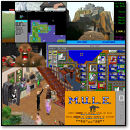[ Newsbits ] April 10, 2014
April 10th, 2014 by Benj Edwards

There are too many good links this week. I honestly don’t know what happened. Maybe I’m getting better at this.
Recent News
- Vintage Computer Festival Southeast 2.0
The AHCS does it again“The Atlanta Historical Computer Society and the Computer Museum of America are pleased to announce the second annual Vintage Computer Festival Southeast. We have selected the dates of the 3rd and 4th of May to make it easy for people to attend both VCF East and VCF Southeast this year.
- Nintendo Launches Game Boy Advance on Wii U Virtual Console
Another painfully slow trickle of games from Nintendo, but the emulation is very well done.“From April 3 through April 24, select Game Boy Advance titles will launch in the Nintendo eShop on Wii U each week. In addition to off-TV play, these games feature Restore Points that save progress during game play, and Miiverse functionality.
- Microsoft Ends Support for Windows XP
Spoiler: It’s not really dead“Windows XP, Microsoft Corp.’s beloved seventh major operating system and arguably the company’s most successful, was left to perish on Tuesday at its creators’ hands. It was 12 years, seven months old.
- Fifty Years of IBM System/360
The most successful computer platform that the least number of people know about“50 years ago today, IBM unveiled the System/360 mainframe, a groundbreaking computer that allowed new levels of compatibility between systems and helped NASA send astronauts to the Moon.
- Gmail 10th Anniversary
A great piece by Harry McCracken I missed last week“If you wanted to pick a single date to mark the beginning of the modern era of the web, you could do a lot worse than choosing Thursday, April 1, 2004, the day Gmail launched.
- Raspberri Pi Announces New “Compute Module”
A new variety of this vertsatile, hackable machine“The compute module contains the guts of a Raspberry Pi (the BCM2835 processor and 512Mbyte of RAM) as well as a 4Gbyte eMMC Flash device (which is the equivalent of the SD card in the Pi). This is all integrated on to a small 67.6x30mm board which fits into a standard DDR2 SODIMM connector (the same type of connector as used for laptop memory*).
Cool Links
- Story of the Windows XP Bliss Desktop Image
Hachman hits it out of the park with this research piece“It’s not too far-fetched to believe that a billion people have viewed the “Bliss” image that defines the desktop view of Windows XP, the seminal OS that Microsoft is retiring Tuesday. But you’d barely notice the real-world “Bliss” scene if you stepped out of your car and gazed at it today.
- A Custom Portable N64 Console
Kotaku drools all over a Bacman forum post“We’ve seen portable retro consoles before, but this N64 mod is beautiful. It uses a 3.5” screen, internal memory and Rumble Pak, an Expansion Pak, a GameCube analog stick and 4 hour battery life.
- Kevin Mitnick Befriends a Former Foe on Facebook
…an old hacking target of decades past“You gotta love the old friends you meet on Facebook.
- Looking at the Web with Internet Explorer 6, One Last Time
Lee Hutchinson explores the modern web with IE 6 in all its splintered glory“Windows XP wasn’t the only thing to be shuffled into unsupported purgatory yesterday. Also included in the group of applications to be dumped down the memory hole is the browser that everyone loves to hate: Internet Explorer 6.
- 1988 Inside Edition Story on Nintendo
Retroist digs up a vintage scare piece“In 1988 parents were still baffled by the spell that video games had cast over their children. This segment from Inside Edition tries to get to to the bottom of it all.
Echo Box
A place for products, creative works, and upcoming projects seeking support. No endorsement from VC&G is implied.
- Project: MEGAFOOT
An indie sci-fi action film seeking funding on IndieGoGo. One of the rewards ($150 level) is a limited edition Megafoot NES cartridge.
Submit News
If you want me to include something on a future Newsbits column, send me an email with “[Newsbits]” in the subject line.













